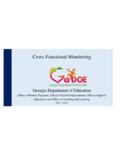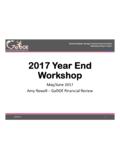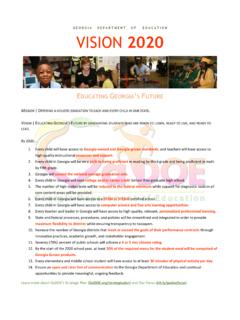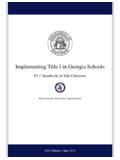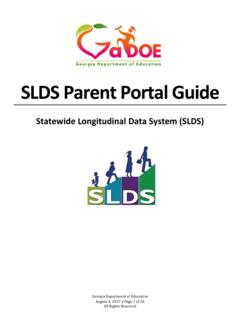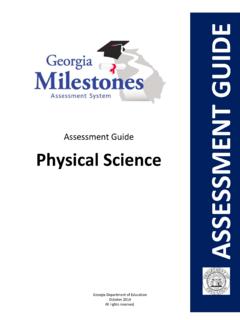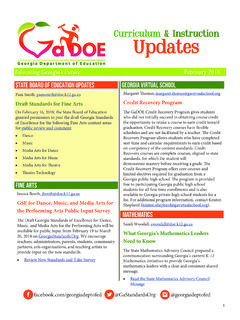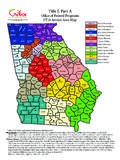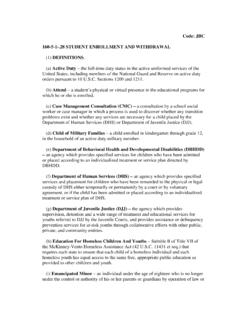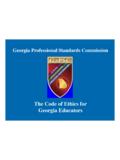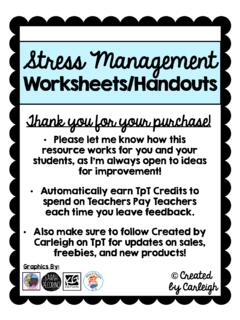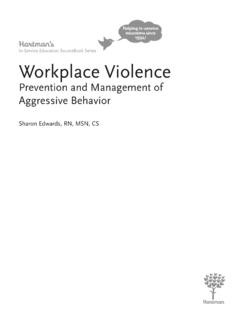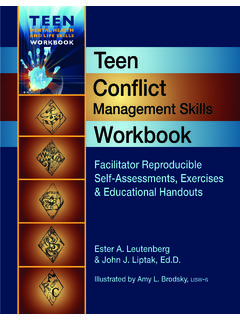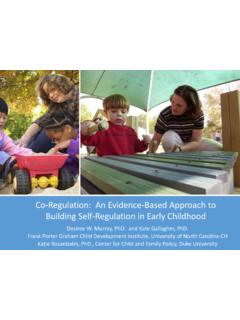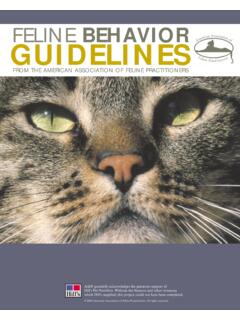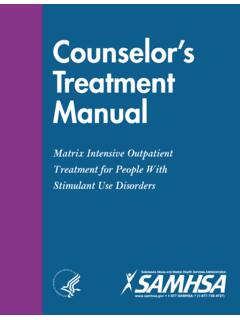Transcription of Social Emotional Learning Strategies
1 Social Emotional Learning Strategies Presented by: Angela Greene, MA Special Education Teacher on Special Assignment for Autism & Emotional Behavioral Disorders Cherokee County School District April, a kindergartner, grew up alone. When she entered school, she was simply fascinated with other children. To get their attention, she grabbed kids around their necks at recess, all the while smiling. When she clutched at them kids called her the mean girl, and at first we agreed. They screamed and she was punished. No one was getting anywhere. Finally we changed our approach. April, are you trying to play with that girl? we asked. Here s how you touch when you want to play, we said. We then asked another child to show April how. When she was no longer seen as mean, other kids rallied to her helping her learn to play. We all just needed to understand differently. (L. Tobin, 1998) A Different Approach .. A Different Approach .. OWhen a middle school student lacks Social skills, what have we been teaching him for eight years that was more important than how to make friends?
2 Why do I need to teach Social Skills? ONOT everyone naturally gets Social skills OThere is a direct correlation between poor Social skills, behavior problems, and academic achievement! Poor Social Skills Behavior Problems Academic Achievement Why Teach Social Skills? OUnderstanding Social interactions helps us to predict the behavior of others OHelps students take part in groups OHelps students form friendships OCost of poor Social skills OAbout 50,000 children and youth die each year because of poor Social skills (Olhoff and Olhoff, 2004) OMore difficulty obtaining and keeping a job Why Teach Social Skills? OPersons with AS have a significantly higher risk for depression (1 in 15) OTeens and adults with AS have a significantly higher rate of suicide OUnable to handle rejection OGreater difficulty with relationships ODifficulty managing their own emotions OOften have fewer skills for dealing with these problems Meltdown Visual Activity Anxiety Points to Consider Regarding Anxiety OIf we can treat Anxiety, we can alleviate opposition.
3 OSome students have the belief that if they can control their environment, they can control their anxiety! OSome students may have learned that intense emotions manipulate others. Anxiety Activity Proactive Not Reactive OTeach the student to have a plan to keep themselves in check: OTeach them breathing techniques OGive them an outlet for tensing muscles such as a stress ball they keep in their pocket OTeach them how to go to their calm place Relaxation Visual Positive Affirmations I ll try my best and that will be good enough! I can do it! I am safe. I will stay calm and relaxed. Special Place Strategy See Handout and You Tube Link: Kid s Relaxation Video: Coping Visual Breathing Visual Student Activity OBreathing Deeply: Have the kids take a deep breath while counting to five. Then as you count back to one, have them slowly release the air. Student Activity OCombined Breathing and Muscle Relaxing: Have the kids pretend they are balloons filling up with air.
4 As you count to five, they slowly breath in and fill up their balloons, stretching and tightening their muscles. Have them hold it a few seconds. Then, as you count back to one again, have them release the air and relax their muscles as though their balloon is deflating. Student Activity OMuscle Relaxing: Have the kids pretend to become frozen by slowly tightening each part of their bodies until they are "frozen solid". Then, let them "thaw" by relaxing each part of their bodies and allowing their anger to melt away. Worry Journal My Worries: How Did I Handle My Worries: Anger management Anger management Activity OWe have to TEACH new coping skills and distraction techniques to keep stressors from piling higher! Brainstorm coping skills we can teach students ! OWhen you are angry, use your stoplight to remind you how to behave appropriately. When you feel like you Omight lose control, STOP. Next, CALM DOWN and think of a solution to your problem. When you are calm, you can GO ahead and solve your problem!
5 Anger Control Stoplight Anger Control Stoplight Use the following scenarios to practice anger management skills while using the stoplight as a visual aide: A sibling is continually teasing you At recess, some kids tell you that you can t join in a game You get home from school only to find that your dog has chewed up a favorite toy You are being picked on by a classmate every day You spill your milk all over the table You lose a game Free Template at: anger%20pdf/anger%20stoplight%20filled% Wheel of Choice Walk away Draw a picture Go cool down Count to 10 I Feel Cards *Tip of the day: Students often need a visual & a word to describe how they are feeling. How to use good impulse Created by Jill Kuzma 10/09 STOP! THINK FREEZE What might happen? Good Idea? or Bad Idea? FOLLOW Responsible Thinking What are you doing? or What did you do? Is that ok? What happens when you _____? Is that what you want to happen? Is _____ going to get you what you want?
6 What are you going to do next time? Incredible 5 Point Scale 5 Point Scale for MS & HS Rating Looks Like Feels Like I Can Try To 5 Kicking or hitting My head will probably explode Call my mom go home 4 Screaming at people almost hitting Nervous Go to see Mr. Peterson 3 Quiet Sometimes rude talk Bad mood grumpy Stay away from kids I don t like 2 Regular kid not wierd Good Enjoy it while it lasts 1 Playing hockey A million bucks Stay that way! Incredible 5 point Scale Templates and Examples Video OIncredible 5 Point Scale Video: Activity Design an Incredible 5 Point Scale: Think about an individual who would benefit from using the Incredible 5-Point Scale. What is the behavior of concern? What does the behavior look/sound like at different levels on the scale? Design a scale. Social Skills Strategies Taking Turns Visual Say Hello Visual Topic Board Visual Conversation Checklist Play Doh People Online Social Skills Tool: Free Social Skills Videos Pie Chart Conversation Skills OLots of people find reciprocal conversation difficult!
7 Remember that person who wouldn t stop talking at the last party you went to? OOur students find reciprocal conversation skills particularly perplexing. They may say little or nothing on the playground or in class discussions. Or they may hold forth in a lecture of monologue fashion, not noticing the signs that others are becoming impatient. Pie Chart Visual Strategy Template for Pie Chart Activity Topic Sticks Activity Poison Thoughts Activity The following activities help students to increase awareness of problem thoughts and beliefs: 1. Make a Poison Thought Game. Scatter the thought bubbles in a jumble all over the floor. Say something like this: We re going to do a kind of matching game. These red thought bubbles are different kinds of thoughts that make people upset. The green ones help to fight the red ones. See if you can find green ones to match up with each of the red ones. 2. Play Hunt for your Poison Thoughts. Say something like: Each person has certain Poison Thoughts that bother them more than other ones.
8 Which ones bother you the most? Which Antidote Thoughts do you need to fight them? You can do this by either scattering the thought bubbles around the floor, or taping them up to a wall, or else by holding them up one at a time in sequence for the child/ children to look at. 3. Fill out the blank thought bubbles. Poison Thoughts Activity Poison Thoughts Activity Template for Poison Thoughts Activity Filtering Thoughts Activity Colander Activity Filtering Thoughts Filtering Thoughts Activity OIn Social skills training in schools and psychotherapy settings, young people on the autism spectrum often struggle with controlling angry verbal outbursts. The Filter the Anger Activity is designed to: Raise awareness of okay vs. not-okay things to say when you are mad Introduce and reinforce the idea that thoughts can be filtered before they are turned into words. Filtering Thoughts Activity Template Mint New Thoughts Activity 1. Now, show the kids how to fill out the OLD THOUGHT money.
9 If you have not already introduced the kids to poison and antidote thoughts, you will want to do this slowly and carefully. You can offer them examples. 2. Have the kids fill out the NEW THOUGHT money now. Provide plenty of extra blank money for them to practice. Tell them that they can use more than one NEW THOUGHT to replace the OLD THOUGHT. 3. Have the kids run the old money through a paper shredder ! Mint New Thoughts Activity Template for Mint New Thoughts Activity Green Zone Activity Green Zone Activity Green Zone Activity Green Zone Activity Template for Green Zone Activity Validating Words OStudents with Social skills deficits might not make typical and expected statements in conversation to indicate interest. This happens for two reasons: might not be at all interested in what the other person is saying. might be interested, but they are not aware of the importance of validating words and phrases in conversation and they are not well practiced in using them.
10 Validating Words Visuals Validating Words Activity OGet a partner. OSpend a minute describing your weekend and have the other person remain silent. OSwitch Roles: Spend a minute describing your weekend and have the other person give validating words. OHow did it feel? OCheck out the validation handout! Template for Validating Words Compliment Tag Compliment Tag OTell the kids: This is Compliment Tag. A compliment is when you say something nice to someone about the way they look, something they have, something they did, something they said, or they way they are. When you play Compliment Tag, the person who is it tries to tag you. To keep from becoming it, you have to give this person a compliment quickly before they tag you. If they tag you before you can give them a compliment, then you are it. OEasy Compliment Tag: Compliment something the person is wearing, hair, shoes, appearance. OHarder Compliment Tag: Compliment something the person is good at.
